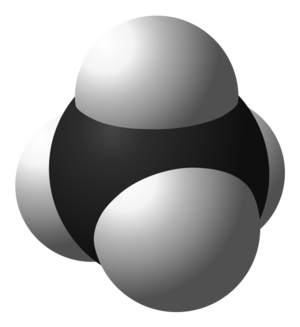Methane: Difference between revisions
J.williams (talk | contribs) m (1 revision imported) |
No edit summary |
||
| Line 1: | Line 1: | ||
[[Category:Done 2015-06 | [[Category:Done 2015-09-06]] | ||
[[File:800px-Methane-3D-space-filling.svg.png|thumb|300px|Figure 1. Space filling model of methane; the white is [[hydrogen]] and the black is [[carbon]].<ref> (2014, Dec. 12). ''Methane-3D-space-filling'' [Online]. Available: http://commons.wikimedia.org/wiki/File:Methane-3D-space-filling.svg#mediaviewer/File:Methane-3D-space-filling.svg</ref>]] | [[File:800px-Methane-3D-space-filling.svg.png|thumb|300px|Figure 1. Space filling model of methane; the white is [[hydrogen]] and the black is [[carbon]].<ref> (2014, Dec. 12). ''Methane-3D-space-filling'' [Online]. Available: http://commons.wikimedia.org/wiki/File:Methane-3D-space-filling.svg#mediaviewer/File:Methane-3D-space-filling.svg</ref>]] | ||
<onlyinclude>'''Methane''' is a [[hydrocarbon]]. At typical [[temperature]]s and [[pressure]]s it is a gas and makes up around 95% of the content of [[liquefied natural gas]], and around 80-90% of [[natural gas]].<ref>(2014, Jun. 10). ''Composition of Natural Gas and LNG'' [Online]. Available: http://www.beg.utexas.edu/energyecon/lng/LNG_introduction_07.php</ref> It is a hydrocarbon, and its chemical makeup is CH<sub>4</sub>. </onlyinclude>Methane is also a [[greenhouse gas]], like [[carbon dioxide]] (CO<sub>2</sub>). It has a shorter [[atmospheric lifetime]] than CO<sub>2</sub>, at 12 years,<ref name=book1>(2014, Jun. 10). ''Direct Global Warming Potentials'' [Online]. Available: http://www.ipcc.ch/publications_and_data/ar4/wg1/en/ch2s2-10-2.html</ref> but this is "balanced" by the fact that it is more effective at trapping heat than CO<sub>2</sub>, as methane has a [[GWP]] ([[Global warming potential]]) of 21.<ref name=book1>http://www.ipcc.ch/publications_and_data/ar4/wg1/en/ch2s2-10-2.html</ref> | <onlyinclude>'''Methane''' is a [[hydrocarbon]]. At typical [[temperature]]s and [[pressure]]s it is a gas and makes up around 95% of the content of [[liquefied natural gas]], and around 80-90% of [[natural gas]].<ref>(2014, Jun. 10). ''Composition of Natural Gas and LNG'' [Online]. Available: http://www.beg.utexas.edu/energyecon/lng/LNG_introduction_07.php</ref> It is a hydrocarbon, and its [[chemical]] makeup is CH<sub>4</sub>. </onlyinclude>Methane is also a [[greenhouse gas]], like [[carbon dioxide]] (CO<sub>2</sub>). It has a shorter [[atmospheric lifetime]] than CO<sub>2</sub>, at 12 years,<ref name=book1>(2014, Jun. 10). ''Direct Global Warming Potentials'' [Online]. Available: http://www.ipcc.ch/publications_and_data/ar4/wg1/en/ch2s2-10-2.html</ref> but this is "balanced" by the fact that it is more effective at trapping heat than CO<sub>2</sub>, as methane has a [[GWP]] ([[Global warming potential]]) of 21.<ref name=book1>http://www.ipcc.ch/publications_and_data/ar4/wg1/en/ch2s2-10-2.html</ref> | ||
Methane [[combustion]] (see simulation at bottom of page) is a significant source of [[primary energy]], and is used for [[home heating]], cooking food, heating water, and [[electrical generation]]; it even provides some [[transportation]]. This means that it is also a significant contributor to [[climate change]] since using methane produces a fair amount of carbon dioxide (although less than other hydrocarbons). | Methane [[combustion]] (see simulation at bottom of page) is a significant source of [[primary energy]], and is used for [[home heating]], cooking food, heating [[water]], and [[electrical generation]]; it even provides some [[transportation]]. This means that it is also a significant contributor to [[climate change]] since using methane produces a fair amount of carbon dioxide (although less than other hydrocarbons). | ||
==Properties== | ==Properties== | ||
| Line 16: | Line 16: | ||
| Energy density<ref name=chemical>(2014, Dec. 12). ''Chemical Potential Energy'' [Online]. Available: http://physics.info/energy-chemical/</ref> || 55.5 MJ/kg | | Energy density<ref name=chemical>(2014, Dec. 12). ''Chemical Potential Energy'' [Online]. Available: http://physics.info/energy-chemical/</ref> || 55.5 MJ/kg | ||
|- | |- | ||
| Melting | | [[Melting point]] || -183<sup>o</sup>C<ref name=melting>(2015, Jan. 29). ''Boiling Points And Structures Of Hydrocarbons'' [Online]. Available: http://www.elmhurst.edu/~chm/vchembook/501hcboilingpts.html</ref> | ||
|- | |- | ||
| Boiling | | [[Boiling point]] || -164<sup>o</sup>C<ref name=melting></ref> | ||
|- | |- | ||
| [[GWP]] || 21 | | [[GWP]] || 21 | ||
| Line 26: | Line 26: | ||
==Combustion Animation== | ==Combustion Animation== | ||
Methane is used as a combustible fuel. Below is an animation showing the net reaction that occurs during the [[hydrocarbon combustion]] of methane. | Methane is used as a combustible [[fuel]]. Below is an animation showing the net reaction that occurs during the [[hydrocarbon combustion]] of methane. | ||
<html><iframe src='http://energyeducation.ca/simulations/combustion/combustion_methane.html' width='900px' height='330px' style='border:none;position:relative;left:-35px'></iframe></html> | <html><iframe src='http://energyeducation.ca/simulations/combustion/combustion_methane.html' width='900px' height='330px' style='border:none;position:relative;left:-35px'></iframe></html> | ||
Revision as of 21:39, 3 September 2015
Methane is a hydrocarbon. At typical temperatures and pressures it is a gas and makes up around 95% of the content of liquefied natural gas, and around 80-90% of natural gas.[2] It is a hydrocarbon, and its chemical makeup is CH4. Methane is also a greenhouse gas, like carbon dioxide (CO2). It has a shorter atmospheric lifetime than CO2, at 12 years,[3] but this is "balanced" by the fact that it is more effective at trapping heat than CO2, as methane has a GWP (Global warming potential) of 21.[3]
Methane combustion (see simulation at bottom of page) is a significant source of primary energy, and is used for home heating, cooking food, heating water, and electrical generation; it even provides some transportation. This means that it is also a significant contributor to climate change since using methane produces a fair amount of carbon dioxide (although less than other hydrocarbons).
Properties
Below is a table of some of the basic properties of methane.
| Chemical formula | CH4 |
| Molar mass | 16.04 grams/mole |
| Energy density[4] | 55.5 MJ/kg |
| Melting point | -183oC[5] |
| Boiling point | -164oC[5] |
| GWP | 21 |
| Atmospheric lifetime | 12 years |
Combustion Animation
Methane is used as a combustible fuel. Below is an animation showing the net reaction that occurs during the hydrocarbon combustion of methane.
References
- ↑ (2014, Dec. 12). Methane-3D-space-filling [Online]. Available: http://commons.wikimedia.org/wiki/File:Methane-3D-space-filling.svg#mediaviewer/File:Methane-3D-space-filling.svg
- ↑ (2014, Jun. 10). Composition of Natural Gas and LNG [Online]. Available: http://www.beg.utexas.edu/energyecon/lng/LNG_introduction_07.php
- ↑ 3.0 3.1 (2014, Jun. 10). Direct Global Warming Potentials [Online]. Available: http://www.ipcc.ch/publications_and_data/ar4/wg1/en/ch2s2-10-2.html Cite error: Invalid
<ref>tag; name "book1" defined multiple times with different content - ↑ (2014, Dec. 12). Chemical Potential Energy [Online]. Available: http://physics.info/energy-chemical/
- ↑ 5.0 5.1 (2015, Jan. 29). Boiling Points And Structures Of Hydrocarbons [Online]. Available: http://www.elmhurst.edu/~chm/vchembook/501hcboilingpts.html


